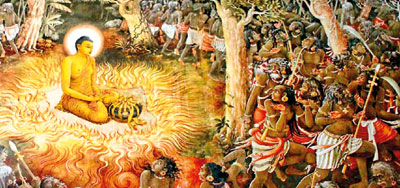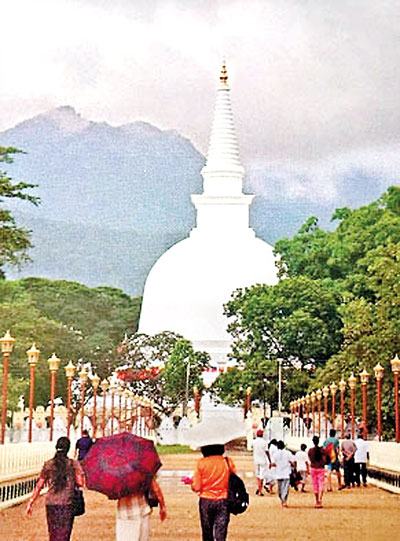Sunday Times 2
Buddha’s first peace mission to Sri Lanka
Today is Duruthu Poya day — the first full moon Poya day of the year.

Soliyas Mendis, the renowned painter has recorded the Buddha’s visit, at the Kelaniya Raja Maha Viharaya, highlighting the Yakkhas running away seeing flames around the Buddha.
Duruthu Poya commemorates the first visit of Gautama Buddha to Sri Lanka nine months after Enlightenment. The visit is recorded in the Great Chronicle Mahavamsa thus: “In the midst of Lanka, on the fair river bank, in the delightful garden three yojanas long and a yojana wide there was a great gathering of the Yakkhas dwelling in the island. To this great gathering of the Yakkhas went the Blessed One, and there, in the midst of that assembly, hovering in the air over their heads, he struck terror to their hearts by rain, storm, darkness and so forth. The Yakkhas, overwhelmed by fear, besought the fearless Vanquisher to release them from terrors.”
The river bank referred to is that of Mahaweli River and the delightful garden has been identified as the Mahiyangana Mahanaga grove.
The Buddha’s visit has been to restore peace among the two main tribes – the Yakkhas and the Nagas who had been fighting constantly. He is believed to have been invited by Sumana Saman Deviyo, the deity of the area. (To this day the deity is respected by the devotees particularly those who climb the Samanala Kanda to venerate the footstep of the Buddha placed there during one of his visits to Sri Lanka).
Not knowing who the stranger was, they thought he was an invader and took to arms to drive him away not allowing him to come down. The Buddha soon dispelled their fears and when they made way, the Buddha came down and preached to them. They were advised to shift to Giripada, possibly in the interior highlands.

The historic Mahiyangana Stupa
Saman Deviyo, who was present, appealed to the Buddha to leave behind a memento which he could venerate after the Buddha departed. The Buddha obliged by giving a few locks of hair (Kesa Dhatu) which were deposited in a gold casket and enshrined in a stupa — the first to be built in Sri Lanka at the site of the Buddha’s visit.
Ranking as the first place to be visited by the Buddha, Mahiyangana is mentioned first in the ‘gatha’ recited to worship the ‘Solosmasthana’ — sixteen places revered by the visits of the Buddha. Thus the stanza starts as ‘Mahiyanganam Nagadeepam Kalyanam Padlanchanam…’ and goes on to mention the places in the order they were visited.
With the ‘Parinirvana’ — the passing away of the Buddha — the collar bone relic (Greeva Dhatu) was recovered from the funeral pyre and brought to Sri Lanka by Arahant Sarabhu and placed in the Mahiyangana stupa built over the original stupa.
Over the centuries, Sinhala kings maintained the stupa and expanded it. It has been recorded that King Devanampiyatissa’s brother (3rd century BC) made the stupa 30 cubits high for greater security.
King Dutugemunu (161-137 BC) stayed in Mahiyangana during his march to Anuradahpura to capture the kingdom invaded by a South Indian king. He increased the dagoba’s height to 80 cubits. It was subsequently rebuilt by King Vijabahau (1055-1110 CE), who ruled from Polonnaruwa.
The Mahiyangana temple has been mentioned in commercial transactions during the time of the ancient kings. The Badulla inscription of King Udaya IV (946-954 CE) refers to commercial activity in the area. According to the regulations found in the inscription, a trader was liable to supply a certain quantity of oil for the lighting of lamps at the temple, if he kept his shop open on a ‘poya’ day. If he failed to do so, a fine was imposed and the collection was used for the same purpose. There is also reference in the inscription that the king used to visit the temple.
When the kings started shifting the capital in fear of foreign invasions and the people too started moving, Mahiyangana, like most other places, was neglected and eventually covered by a jungle.
It was in the early 1940s that the need to restore Mahiyangana was seriously looked at. D S Senanayake, the then Agriculture and Lands Minister, took the initiative to form the Mahiyangana Restoration Committee which he headed. The restoration work continued for more than a decade.
With roads being built and the area developed, the Mahiyangana Raja MahaViharaya became a popular place of Buddhist worship for devotees during their ‘vandanagaman’.

